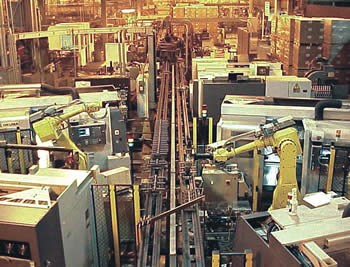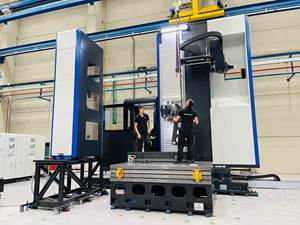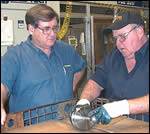Turning The Tide
When Briggs & Stratton decided to make the crankshaft machining lines in its Poplar Bluff plant globally competitive, it had to choose between CNC lathes and dedicated special machines for its main turning operations. The company chose the lathes.
Share


The Briggs & Stratton plant in Poplar Bluff, Missouri, is putting the final touches on a multimillion-dollar upgrade to its crankshaft machining area. These crankshafts are a critical component in the numerous small engines that the company supplies to manufacturers of walk-behind lawn and garden equipment. The plant produces about 3.3 million of these engines a year, and the crankshaft in each one is machined in this facility.
That’s one of the main reasons why the crankshaft machining area became the plant’s focus of attention about 3 years ago. It was a production bottleneck; quality issues were a problem; and costs were an issue.
By implementing automation and other production efficiencies, the operation is now able to meet its goals for productivity, cost and quality. The newly automated lines require less floor space than the original lines, take fewer operators and setup staff to run and are more flexible. Part number change-overs are faster, and new parts can be added without major modifications to the equipment. More importantly, it is clear that the implementation is achieving its objectives. Those are: meet all the specs on the part print; produce a finished crankshaft every 10 seconds; and operate at 85 percent efficiency or better on a consistent basis.
The main turning operations in the revamped lines are performed in two automated cells. Each cell consists of four twin-turret CNC lathes, with an automated gaging station and a robot for each pair of lathes. Other turning and grinding operations are also now performed in automated, robotically tended cells. What makes the main turning cell significant is the choice of standard CNC equipment. These lathes are high-precision models that might be found in a dealer’s showroom or on the floor of an advanced job shop.
The decision to incorporate CNC lathes in these cells was made carefully. The performance of these lathes was essential to the success of the whole automation project. Recent innovations in the design and control structure of these machines made this application possible. By installing these lathes, turning steps could be consolidated, a rough grinding step could be eliminated and higher accuracies could be achieved on critical part features.
Choosing CNC lathes and robots over alternative equipment, however, was not the most important decision the company had to make for this plant. Whether to upgrade the crankshaft machining area at all, or join to the tide and outsource production was the crucial choice. For some large manufacturing companies, this decision would not have been a matter of debate. That was almost the case in Poplar Bluff.
The story began in late spring of 2002. It started with a telephone call.
Shutdown Time
Chris Peters, who manages the crankshaft machining area at the Poplar Bluff plant, answered the telephone. The vice president and general manager of the division was calling, and he asked Mr. Peters about his shutdown plans for the crankshaft machining operation. At first, he treated this call as a routine request—every July, the plant has a 2-week shutdown. It’s a period when most employees schedule at least part of their vacation time and when major maintenance or renovation can occur with the least disruption. Procedures for this annual shutdown are well established and follow the same pattern year after year. Mr. Peters assumed that all he needed to do was check for any circumstances that might change these plans and then reassure his boss that the shutdown would proceed as usual.
He soon learned that he had misunderstood the message. Mr. Peters was being asked to plan for a total shutdown of the crankshaft machining area. The company was seriously considering outsourcing this product. It was time to look at an orderly cessation of production, redeployment of area employees and disposal of the equipment.
That was not a decision that Mr. Peters expected, even though he knew that the crankshaft area had some deficiencies that needed to be addressed. These concerns had been put off because of other priorities in the plant and competing budgetary considerations. Outsourcing is always an option for companies that are concerned about global competitiveness, and Mr. Peters certainly understood that. He had hoped that the crankshaft line would have its chance to be revitalized, but it looked as if this chance would never come.
Mr. Peters is not one to quietly abandon a conviction. He believed that crankshaft production could stay at the Poplar Bluff plant and be globally competitive if the commitment to the engineering effort and investment in automated equipment were put forth. Fortunately, Briggs & Stratton is committed to globally competitive manufacturing in all its plants. What mattered was reaching that goal—all the better if crankshaft machining could reach that goal in Poplar Bluff.
With that encouragement, Mr. Peters began meeting with the engineers, supervisors and plantfloor staff in the crankshaft area. Manufacturing Engineers Stahl Sturgeon and Jesse Sumrall; and Shift Supervisors Jim Boshell, Jim Plumb and Ken Stout played key roles in this process. It took about a year to create a long-range plan for upgrading and automating crankshaft production. Everyone who participated in these planning sessions understood that being globally competitive involved four broad objectives:
- Improve efficiency
- Increase productivity
- Enhance quality
- Raise technical competence
The long-range plan presented in early 2004 outlined how each of these objectives could be met. This plan also included a detailed rationale for the selection of preferred processes and vendors. The analysis of CNC lathes versus special machines was especially revealing.
Based on the balanced but convincing elements of the plan and its financial justification, the company agreed to go along. The total cost was projected to be close to $5 million, and implementing the plan would take almost 2 years.
More Than Automating
Early in the planning process, it became apparent that simply applying automation to existing processes would be insufficient. More than new robots would be needed. Comments and insights from the machining line operators suggested that a reprocessing of the crankshafts could reduce machining time and eliminate steps. Mr. Peters says that this input proved to be indispensable as planners developed their concept. This input figured prominently in analyzing the value of CNC equipment as well.
A summary of this analysis is presented in the table on the next page. Although the merits of CNC equipment over customized special machines were clear, the company had generally preferred special machines in earlier automation initiatives, so it was important for planners to establish the advantages of CNC.
Selecting the preferred vendor for this equipment was given an equally thorough analysis. Vendors were rated and ranked according to seven key factors:
- Cost
- Equipment design (was it simple, reliable and common?)
- Layout (floor space requirements)
- History (satisfactory experiences in the past)
- Technology co-vendors (strength of subcontractors)
- Proof of Process
- Training
Of these, the last three proved to be the factors that distinguished the preferred vendor. For example, of the five machine tool organizations considered, only Okuma offered proof of process—machining time studies that demonstrated the necessary process capability. These tests were conducted by Hartwig, Inc., a machine tool distributor with headquarters in St. Louis, Missouri. Hartwig has been representing this builder in the region for more than 25 years.
| Process Selection—Equipment Comparison | |||
|
Feature |
Special Machines | CNC | Comments |
| Cost |
X | CNC has a much lower cost | |
| Flexibility | X | Can use CNC for new applications | |
| Cycle |
Time for both is 10 seconds | ||
| Efficiency | X | Multi-path flow can keep line running | |
| Part Tracking | X | Single-path flow allows easy tracking | |
| Tooling | X | CNC uses standard holders and inserts | |
| Floor Space | X | Some special machines are the same as CNC | |
| Maintenance | X | Reliable service and easy access | |
| History | X | CNC is a proven technology | |
| Conclusion: CNC is our preferred process. | |||
| This comparison of special machines and stand-alone CNC lathes helped the company select what appeared to be the best choice for automating the main turning operations on the crankshaft lines. | |||
Significantly, two factors not related to technical characteristics of the machines were given considerable weight. “We really needed a vendor organization that could take single-source responsibility for the turning cells,” says Mr. Peters, adding that this responsibility included training, which was considered to be very important. As the Okuma distributor, Hartwig stood out in these aspects. Hartwig had an engineering staff with both machining and automation experience. The company was ready to assign a project manager who could coordinate and facilitate all interactions with the Briggs & Stratton team in Poplar Bluff. (Hartwig’s Craig Jung, an applications engineer, took on this role.)
In addition, Hartwig had a strong relationship with Automated Concepts, Inc. (ACI), a systems integrator, in Council Bluffs, Iowa. As a “technology co-vendor,” ACI’s engineers not only could integrate the robotic workhandling, but also they could integrate the automatic gaging stations.
It helped that Hartwig’s St. Louis headquarters was only a few hours’ drive from the plant. Working with a local organization that could provide the extensive training needs the plans required was a big plus. “Hartwig’s commitment to training exactly matched our expectations,” Mr. Peters says, noting that it would be difficult to overestimate the importance of providing plant personnel with adequate training on startup, operation and maintenance of the installed equipment.
Finally, this distributor’s proximity was an advantage in providing systems support and service. A Hartwig-based Okuma service technician would be available virtually around the clock.
Cranking Out Crankshafts
In its final configuration, the automated crankshaft area conducts the main turning operations on two identical cells. There is one cell in each of the parallel machining lines. Both cells on the two lines are built around eight Okuma LU-300 lathes that face each other in pairs on opposite sides of the moving parts conveyor. A pedestal-mounted Fanuc M710iB robot is positioned in the middle of each pair of lathes, but lockout safety fencing allows the cells to be isolated into single-machine zones. This allows cell operation to continue while one of the machines is sequestered for maintenance.
The twin-turret design allows both ends of the crankshaft to be machined simultaneously in one fixturing, whereas these ends were machined separately on the former lines. These machines are equipped with ballscrew-driven, servo-actuated doors that have a 1-second open and close time, which minimizes load and unload cycle times. Mr. Jung reports that these lathes are the first such machines to be installed in the United States.
More importantly, these lathes are able to hold the 0.0005-inch tolerances as specified for turned features of the crankshafts. In machining trials and time studies, these machines held a consistent Cpk of 1.67. According to Mr. Jung, rotary encoders on the ballscrews read 1,296,000 pulses per revolution. Such a high resolution allows the machine to make adjustments to infeed commands in 0.0001-inch increments, based on feedback from the gaging stations. This capability is the key to effective closed-loop control, he says.
The high accuracy of these turning operations eliminates the entire rough grinding step that was formerly required. Rough grinding was a particularly troublesome bottleneck on the former lines and a persistent source of errors. Just by eliminating this rough grinding step, the gained efficiencies allow two machining lines to match the output of three lines in the old configuration.
Obviously, the automatic gaging stations play a key role in each cell. Mr. Peters attributes the low scrap rate of the main turning operations to the closed-loop feedback provided by these stations. (The overall scrap rate is less than 1 percent). The gaging stations were designed and constructed by Edmunds Gages (Farmington, Connecticut).
Each gaging station simultaneously measures five dimensions of every crankshaft machined in the cell. The gage’s data processor tracks every crankshaft and offsets any one or all of these dimensions. Feedback to the lathe’s CNC is used to compensate for these deviations. ACI developed the interface for this feedback system.
If a turned crankshaft exceeds the tolerances on any of the dimensions, then the robot takes it to the scrap bin. Otherwise, the part is placed on the conveyor for transport to the pin turning and grinding cells.
Currently, 18 different crankshaft types are processed. The robot grippers, designed by ACI, can handle any style. The lathes and gaging stations must be changed when moving from one type to another. According to Mr. Peters, the lathe can be changed over in about 8 to 10 minutes, one of the key aspects that led to choosing CNC equipment. The gages can be remastered in about half an hour. Change-overs can occur at any time, depending on vagaries in the production schedule; however, two or three change-overs per week per line are typical.
Having lathes with two turrets in an automated production environment creates some interesting tooling strategies. Turret stations are set up alternately with toolholders for roughing and finishing inserts (all easily obtained, off-the-shelf items). Insert corners are changed after every 150 cycles. The capacity of the turrets (eight stations on the lower turret, 12 on the upper) minimizes insert changing and keeps total cost of tooling consumables for the line very low.
Automation, Productivity And Jobs
With automation in place, one setup person is assigned to monitoring and tending four lathes within a cell. Similar productivity gains across the entire crankshaft machining area have resulted in a substantial reduction of staff requirements. The operator staff has been reduced by 54 people, and the setup staff has been reduced by 12 people.
As it turned out, no layoffs occurred because of the automation. According to Mr. Peters, normal attrition and reassignment opportunities absorbed the superfluous positions. To further emphasize the positive, he points out that the remaining jobs are far less vulnerable to low-wage competition. Nevertheless, reassuring the plant workforce about the need to automate was a constant priority for Mr. Peters and his team. Communicating this message frequently helped make the transition smooth and more effective.
“If there is a secret ingredient in making a big project like this successful, then it’s having a workforce that is open to change and willing to work with automation and robotics,” Mr. Peters concludes. “Some of this was pretty scary at first,” he admits, “but we always had the cooperation and input we needed from the setup and operator staff. Ultimately, they made it happen. We were also fortunate in this plant to have a highly talented, technical and energetic maintenance department to support this massive installation. Other departments in the plant had extra work to do, too, as a result of this project, and we could count on their support as well.”
The larger message to other U.S. companies is that all manufacturing operations must be globally competitive to survive. That requirement is unassailable. What may be overlooked or misbelieved is that manufacturing in this country can achieve the level of mandatory productivity, efficiency and quality with available technology. The technology simply needs a chance to show what it can do.
Given the chance, it will prove that outsourcing is not the only way to go.
Related Content
Controlling Extreme Cutting Conditions in Large-Part Machining
Newly patented technologies for controlling chatter and vibration during milling, turning and boring operations promise to drastically reduce production time and increase machining performance.
Read MoreOrthopedic Event Discusses Manufacturing Strategies
At the seminar, representatives from multiple companies discussed strategies for making orthopedic devices accurately and efficiently.
Read MoreA History of Precision: The Invention and Evolution of Swiss-Style Machining
In the late 1800s, a new technology — Swiss-type machines — emerged to serve Switzerland’s growing watchmaking industry. Today, Swiss-machined parts are ubiquitous, and there’s a good reason for that: No other machining technology can produce tiny, complex components more efficiently or at higher quality.
Read MoreBallbar Testing Benefits Low-Volume Manufacturing
Thanks to ballbar testing with a Renishaw QC20-W, the Autodesk Technology Centers now have more confidence in their machine tools.
Read MoreRead Next
Sourcing Automation
A new kind of 'automation project manager' helped this company install a roboticized machining cell, the first of several now operating in its plant.
Read MoreJust Enough Automation
Automated gantry loaders helped this shop make the transition from job shop to product line manufacturer.
Read MoreOEM Tour Video: Lean Manufacturing for Measurement and Metrology
How can a facility that requires manual work for some long-standing parts be made more efficient? Join us as we look inside The L. S. Starrett Company’s headquarters in Athol, Massachusetts, and see how this long-established OEM is updating its processes.
Read More











%20checks%20on%20machining%20line%20with%20Greg%20Hartwig.jpg;width=700;quality=80)












.png;maxWidth=300;quality=90)







